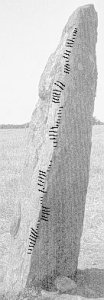Location and history:
The inscription was mentioned as "Greenhill" in Brash, JRSAI 10, 1869, 258 as an example for an element RITTI; cf. {106}.
Size according to Macalister, CIIC: 8'1" x 1'10" x 1'0"
- Published illustrations:
- Brash, OIM,
 Pl. XII (draft);
Pl. XII (draft);- Macalister, Epig. 3, 104 (sketch);
- Macalister, CIIC 62 (sketch).
- Macalister, Epig. 3, 104 (sketch);
Reading Brash, OIM 137:
TTGENUMAQIMUCOIQRITTI
"DGENU MAQI MUCOI QRITTI"
"GENU THE SON OF THE SWINEHERD CURITT".
[p. 140:] CURITTI appears also on the stones at Ballyneanig {146}, Ballinrannig {149}, and Ballyvooney {270}; without "prefix" it occurs in the forms RITTI͵ RITTE͵ RITTOS. Cp. Gaul. Rita and the tribe of the Curetes mentioned by Dionysius Halikarnassos.
Reading Ferguson, OI 88 (138.):
TRENU or TRENI MAQI MUCOI QRITTI
Reading Macalister, Epig. 3, 103 (160.):
TRENUMAQIMUCOIQRITTI
Reading Macalister, CIIC:
TRENU MAQI MUCOI QRITTI
Interpretation Korolev, DP, 64:
TRENU MAQI MUCOI QRITTI
Reading Gippert:
 Angle, up:
Angle, up:T(R)EN(U MA)Q[I MU]COI Q(R)ITTI
ᚈ(ᚌ)ᚍᚓᚅ[ᚒᚋᚐ]ᚊ[ᚑᚑᚋᚒ]ᚉᚑᚔᚊᚌ(ᚍ)ᚔᚈᚈᚔ
ᚆᚆᚆ(ᚋᚋᚋ)ᚋᚋᚐᚐᚐᚐᚁᚁᚁᚁᚁ(ᚐᚐᚐᚋᚐ)ᚆᚆᚆᚆᚆ(ᚐᚐᚐᚐ)[ᚐᚋᚐ](ᚐᚐ)ᚆᚆᚆᚆᚐᚐᚐᚐᚐᚐᚐᚆᚆᚆᚆᚋᚋ(ᚋᚋᚋ)ᚐᚐᚐᚐᚐᚆᚆᚆᚆᚆᚆᚐᚐᚐᚐᚐ
 R can be ascertained by its slant only, comparing it with the T-.
R can be ascertained by its slant only, comparing it with the T-.